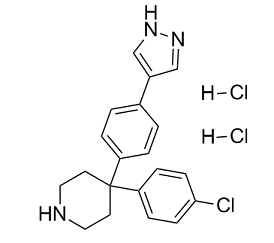AT7867 Dihydrochloride
This product is for research use only, not for human use. We do not sell to patients.

For small sizes, please check our retail website as below: www.invivochem.com
| Size | Price | Stock |
|---|---|---|
| 100mg | $700 | Check With Us |
| 200mg | $1050 | Check With Us |
| 500mg | $1770 | Check With Us |
Cat #: V11795 CAS #: 1431697-86-7 Purity ≥ 99%
Description: AT7867 Dihydrochloride is a novel, highly potent and ATP-competitive inhibitor of Akt1/Akt2/Akt3 and p70S6K/PKA with IC50s of 32 nM/17 nM/47 nM and 85 nM/20 nM in cell-free assays, respectively.
Top Publications Citing Invivochem Products
Publications Citing InvivoChem Products
Product Promise

- Physicochemical and Storage Information
- Protocol
- Related Biological Data
- Stock Solution Preparation
- Quality Control Documentation
| Molecular Weight (MW) | 410.77 |
|---|---|
| Molecular Formula | C20H22Cl3N3 |
| CAS No. | 1431697-86-7 |
| SMILES Code | ClC1=CC=C(C2(C3=CC=C(C4=CNN=C4)C=C3)CCNCC2)C=C1.[H]Cl.[H]Cl |
| Synonyms | AT-7867 Dihydrochloride; AT7867 Dihydrochloride; AT 7867 Dihydrochloride; |
| Protocol | In Vitro | The inhibition of AKT2 by AT7867 is shown to be ATP-competitive with a Ki of 18nM. AT7867 also displays potent activity against the structurally related AGC kinases p70S6K and PKA, but shows a clear window of selectivity against kinases from other kinase sub-families. In vitro growth inhibition studies show that AT7867 blocks proliferation in a number of human cancer cell lines. AT7867 appears to be most potent at inhibiting proliferation in MES-SA uterine, MDA-MB-468 and MCF-7 breast, and HCT116 and HT29 colon lines (IC50 values range from 0.9-3 μM), and least effective in the two prostate lines tested (IC50 values range from 10-12 μM) . |
|---|---|---|
| In Vivo | Following oral administration at 20 mg/kg, the elimination of AT7867 from plasma appears to be similar to that observed after i.v. administration. Plasma levels of AT7867 remain above 0.5 μM for at least 6 hours following an oral dose of 20 mg/kg. Assuming linear pharmacokinetics following i.v. administration, the bioavailability by the oral route is calculated to be 44%. In vivo pharmacodynamic (PD) biomarker studies are therefore performed with this model. Following pharmacokinetic and tolerability studies, doses of AT7867 (90 mg/kg p.o. or 20 mg/kg i.p.) are administered to athymic mice bearing MES-SA tumors and the phosphorylation status of GSK3β and S6RP in tumors is monitored over time. Clear inhibition of phosphorylation of the two markers of pathway activity is seen at 2 and 6 hours following treatment with AT7867. By 24 hours, total levels of both GSK3β and S6RP are greatly reduced. |
These protocols are for reference only. InvivoChem does not
independently validate these methods.
| Solvent volume to be added | Mass (the weight of a compound) | |||
|---|---|---|---|---|
| Mother liquor concentration | 1mg | 5mg | 10mg | 20mg |
| 1mM | 2.4345 mL | 12.1723 mL | 24.3445 mL | 48.6890 mL |
| 5mM | 0.4869 mL | 2.4345 mL | 4.8689 mL | 9.7378 mL |
| 10mM | 0.2434 mL | 1.2172 mL | 2.4345 mL | 4.8689 mL |
| 20mM | 0.1217 mL | 0.6086 mL | 1.2172 mL | 2.4345 mL |
The molarity calculator equation
Mass(g) = Concentration(mol/L) × Volume(L) × Molecular Weight(g/mol)
Mass
=
Concentration
×
Volume
×
Molecular Weight*
The dilution calculator equation
Concentration(start)
×
Volume(start)
=
Concentration(final)
×
Volume(final)
This equation is commonly abbreviated as: C1 V1 = C2 V2
Concentration(start)
C1
×
Volume(start)
V1
=
Concentration(final)
C2
×
Volume(final)
V2
Step One: Enter information below
Dosage mg/kg
Average weight of animals g
Dosing volume per animal µL
Number of animals
Step Two: Enter the in vivo formulation
%DMSO
+
%
+
%Tween 80
+
%ddH2O
Calculation Results:
Working concentration:
mg/ml;
Method for preparing DMSO master liquid:
mg
drug pre-dissolved in
µL
DMSO(Master liquid concentration
mg/mL)
,Please contact us first if the concentration exceeds the DMSO solubility of the batch of drug.
Method for preparing in vivo formulation:
Take
µL
DMSO master liquid, next add
µL
PEG300, mix and clarify, next add
µL
Tween 80,mix and clarify, next add
µL
ddH2O,mix and clarify.
Note:
- (1) Please be sure that the solution is clear before the addition of next solvent. Dissolution methods like vortex, ultrasound or warming and heat may be used to aid dissolving.
- (2) Be sure to add the solvent(s) in order.




































